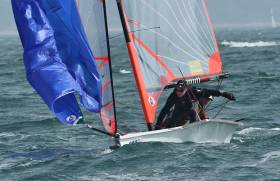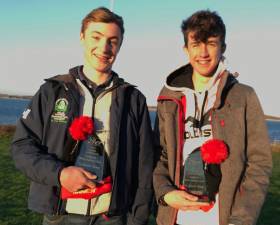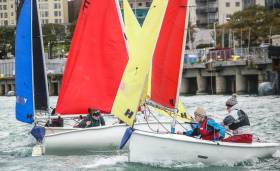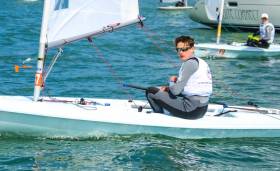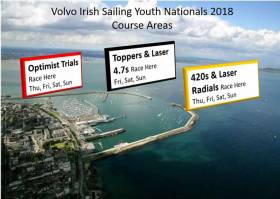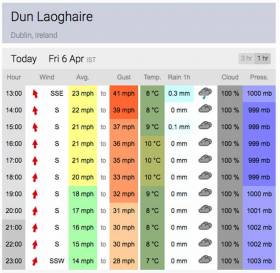Displaying items by tag: youth sailing
Irish Youth Sailors Medal at RYA Youth Nationals 2019
The RYA were issuing invitations to visiting sailors for the 2019 event in Weymouth so it gave the opportunity for a few Irish boats to compete at the premier British Youth Sailing event of the year writes Thomas Chaix
The RYA Youth Nationals 2019 produced seven days of great competition on the water of Weymouth Bay and Portland Harbour.
The Irish contingent was composed by eight 29er partnerships (showing once more that the fastest growing class in Ireland is also keen to show its competitiveness against the well established UK class), two 420 partnerships, three Laser radials and two laser 4.7s. For the 29ers and the 420s, the event was also part of the trials process to earn selection into the Youth Worlds 2019 Irish team.
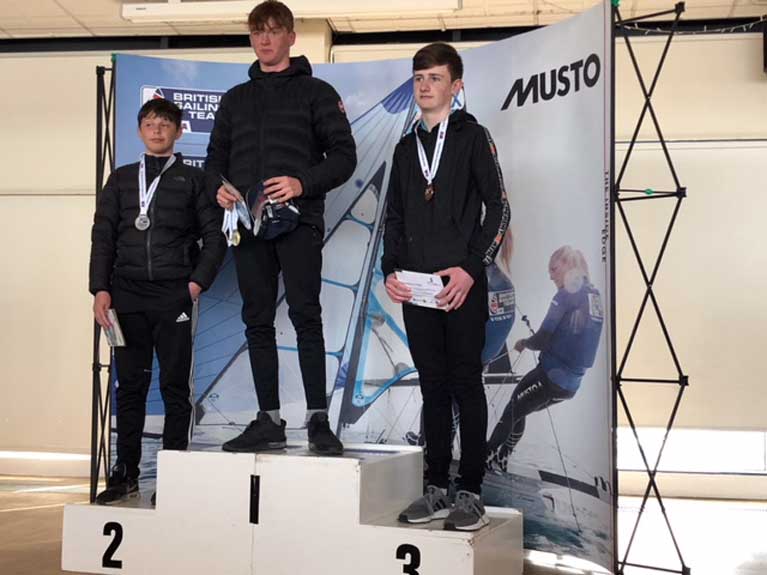 The Laser 4.7 podium with Michael Crosbie taking bronze
The Laser 4.7 podium with Michael Crosbie taking bronze
Laser 4.7
The Laser 4.7 class competed over a 4-day event and after 7 races, Michael Crosbie secured a bronze medal with a solid series including a race win and a 2nd. His teammate from Cork, Jonathan O’Shaughnessy, completed his challenge in 17th in the 45 boat fleet.
The youth classes competed over 5 days. It was certainly a challenging week with wind in excess of 25 kts on the first day followed by light and shifty conditions on day two, a long waiting day with fog midweek, a marathon fourth day with the 29ers on deck for over 10 hours, and finally glorious sunshine with dying wind on the final day.
Radials
The Laser radials completed 9 races. Dan McGaughey (Ballyholme) was top of the Irish in 13th overall with a series including three top 10 finishes. Moss Simmington concluded his event 24th and 6th U17 a few places ahead of Joseph Karauzum who was very happy with a 6th on his final race in the 50 boat fleet.
420
The 30 entry 420 fleet completed 8 races. Morgan Lyttle and crew Patrick Whyte (RStGYC) completed the event in 13th position overall to top the Irish hopes.
Irish 29er Class
The Irish 29er class is not short of enthusiasm and progress is stellar in a class that is only in its second year of existence in Ireland. Eight partnerships travelled to Weymouth and competed in the 11 race series in the largest fleet of the event with 61 boats racing.
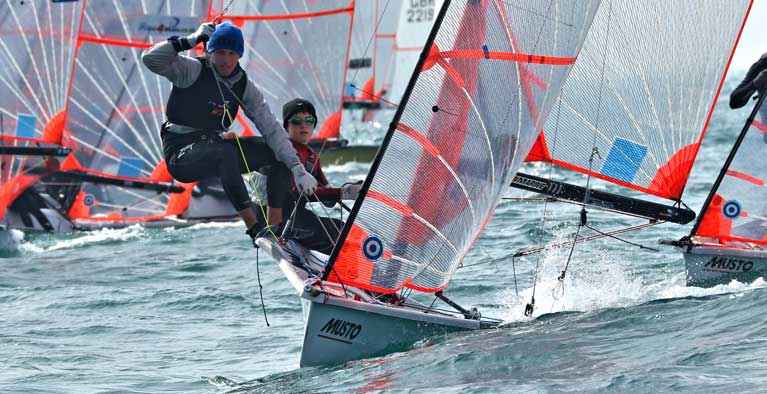 Harry Twomey and Harry Durcan
Harry Twomey and Harry Durcan
As Afloat previously reported, the Irish raced well to collect several honours. Harry Twomey with class veteran Harry Durcan on the wire secured 3rd overall and silver medal in the boys after a strong series including 2 race wins. Not far behind, Rian Geraghty-McDonnell and crew Nathan Van Steenberge (NYC), also scoring 2 race wins, took 6th overall and top U17. It was no small achievement as the boys have now secured a “hat trick” having won the U17 category in all 3 events they attended in the UK since November! Also in the top 10 were Leah Rickard (NYC) and Eimer McMorrow Moriarty (TBSC) in 9th overall, bronze medal amongst the girls, and best U17 girls. Their impressive series included three 2nds.
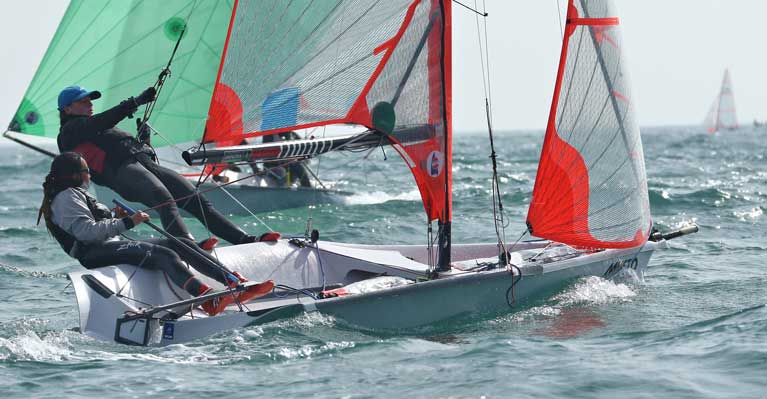 (Above and below) Leah Rickard (NYC) and Eimer McMorrow Moriarty (TBSC) were 29er bronze medal amongst the girls and best U17 girls Photo: Simon McIlwaine
(Above and below) Leah Rickard (NYC) and Eimer McMorrow Moriarty (TBSC) were 29er bronze medal amongst the girls and best U17 girls Photo: Simon McIlwaine
The remaining Irish had their ups and down with Emily Riordan (RStGYC) and crew Max Goodbody (RIYC) winning silver fleet a couple places ahead of Charlie Cullen and Ben Hogan (NYC & RStGYC) who took the bullet in the final silver fleet race.

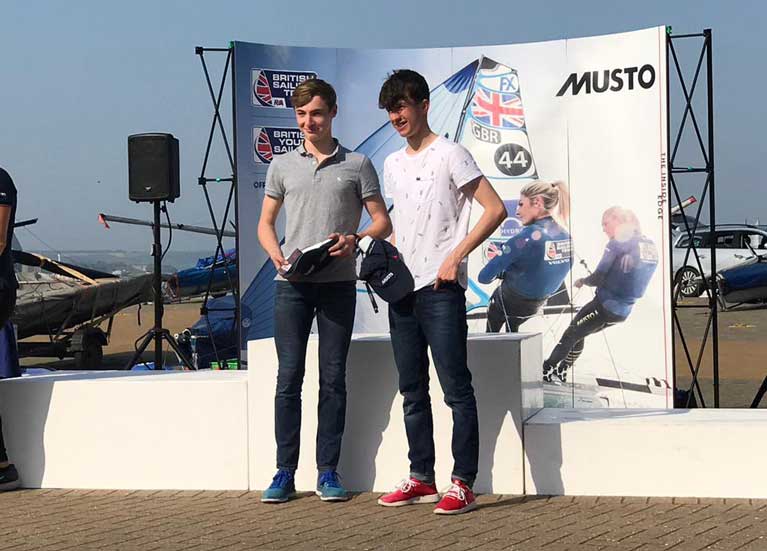 Rian Geraghty-McDonnell and crew Nathan Van Steenberge were top U17 team in the 29er
Rian Geraghty-McDonnell and crew Nathan Van Steenberge were top U17 team in the 29er
Sailing Youth Worlds Selection
The event was also the final leg of the Irish Sailing trials for selection into the Sailing Youth Worlds in Poland (Gydnia) in July. For the boys, Rian Geraghty-McDonnell and Nathan Van Steenberge's commanding performance secured their selection. Leah Rickard and Eimer McMorrow Moriarty also secured their ticket to Poland, becoming the first female Irish team to represent Ireland in the 29er in the Youth Worlds.
As usual, the British produced a very well run regatta under the leadership of event PRO Peter Saxton and we can only hope they will continue to issue invitations to Irish sailors and give us the opportunity to compete against the best Youth sailors from Britain.
More than 150 young sailors with hopes of 'Olympic glory' will get the chance to take the first steps towards fulfilling their dreams at the Irish Sailing Youth National Championships at the Royal Cork Yacht Club later this month from 25-28 April at Crosshaven in Cork Harbour.
The competition is the one time every year when the best of Irish youth sailing come together to test their skills and ability to perform under intense competition conditions – with the added pressure of being under the spotlight for the selectors from Irish Sailing Performance.
The youngsters from throughout Ireland will compete across five different classes of boat during the weekend – the Laser Radial, Laser 4.7, 420, Topper and Optimist. These five classes have been identified, say Irish Sailing, as those that develop the necessary experience sailors need to successfully develop their skills from junior through to the Olympic classes and competing internationally.
As well as racing, there are three evening talks from members of the Irish Sailing Team. Those attending will be treated to 'inspirational talks' from Katie Tingle, who now partners Olympic silver medallist Annalise Murphy in the 49erFX as they seek Olympic qualification this year. Royal Cork's Tingle should have plenty to talk about as she will have made her international 49erFX debut in the class the week previous at the World Cup in Genoa starting on April 14.
49er sailor Séafra Guilfoyle, a silver medallist at the 2014 Youth World Championships and current partner of Ryan Seaton, who was a finalist at the Olympic Games in London 2012, and Rio 2016; and James O’Callaghan, Irish Sailing’s Performance Director, who will discuss resetting and refocusing during competition with Jessie Barr, Olympic athlete and Sport Ireland sports psychologist.
The occasion also is one of the few times where families and friends competing in the different classes can gather together in one location to share their experiences, learning and generally have some fun.
Sean Evans, Irish Sailing’s Olympic Laser Radial Academy Coach said “The Irish Sailing Youth National Championships are Ireland’s largest Youth regatta and our sport’s primary talent spotting event of the year. All the young sailors that are competing over the weekend have every chance of being selected for the Irish Sailing Academy. Sailors who demonstrate their proficiency at these championships can be chosen for squads that will be competing abroad and may even give something back by coaching and training others as well”.
Finn Lynch, just back from placing 4th in the Laser Class at the Trofeo Princesa Sofia in Palma said “I've great memories of the Youth Nationals, competing with my mates for the right to represent Ireland, racing was always great and the competition was fierce!”.
The Irish Sailing Youth National Championships, showcasing the best up-and-coming talent in Ireland, will take place from 25th-28th April at the Royal Cork Yacht Club, Crosshaven.
National Yacht Club Pair Win Junior UK 29er Inland Championships
Coach Thomas Chaix travelled with two Irish 29er pairs to Grafham Waters in the UK over the weekend to compete at the Inland Championships. The two pairs competed in the 42 boat fleet. Eight races were sailed in 8 to 18 kts providing a range of conditions suiting all level of skills.
Rian McDonnell Geraghty and Nathan Van Steenberge, both from the NYC sailed a very strong series (10-7-6-4-4-14-BFD-6) to take 7th overall and very comprehensively win the Junior (U15) category. It is a very encouraging result for the very ambitious young pair who teamed up on this demanding little skiff just 2 months ago. Early dividends for all the hard work at training is always nice to take!
NYC Leah Rickard, freshly returning from Injury and crew Kerry based Eimer McMorrow-Moriarty had highs and lows showing great skills in the lighter breeze early on topping their series with a 12th on race 2. Both were also competing in the junior category and they secured 6th for their first regatta together.
The 29er class is a growing class in Ireland with new boats and new partnerships getting hooked on this fast, yet challenging to master youth skiff. Exposure to the well established UK class is great for these young teams to gauge their progress.
Top Juniors Will Race Fireflies to Decide All Ireland Youth Sailing Title at Royal St. George Yacht Club
The Junior Irish Sailing All Ireland Sailing Championships will be held this weekend (29-30 September) at the Royal St George Yacht Club in Dun Laoghaire on Dublin Bay using Firefly dinghies.
The Junior competitors include three female teams, lead by Alana Coakley (RSGYC), Grace O’Beirne (RSGYC), and Nell Staunton (National YC) who placed eighth in the Laser Radial 2018 Youth Sailing World Championships this summer in Texas.
Last year’s winner Micheal O’Suilleabhain (Kinsale YC) will compete alongside Tom Higgins (RSGYC) representing the first Team Racing entry and fresh from his top 10 placing at the Laser Radial Youth Worlds in Kiel; and two double nominees: Ben Graf (Lough Ree) who was nominated by both the RS Feva and Mirror classes, and Atlee Kohl (RCYC) nominated by the Laser 4.7s and 29er classes.
There’s also a strong Royal Cork Yacht Club representation – five out of sixteen nominations are from Crosshaven in Cork Harbour. Full list of invitees is here.
Lough Ree Yacht Club (LRYC) have created an event that brings all competitive youth double-handers to one location for a weekend of fun and racing. Now, after the inaugural success of 'Double Ree' last weekend, the only question for the County Westmeath sailing club is whether 'Double Ree' should be held every double year? LRYC Commodore Garrett Leech reports.
What a showcase for double handed boats it was! 58 boats entered the event with 57 actively competing, this translated to 114 sailors on the start line; 8 29ers, 16 420s, 15 RS Fevas and 18 Mirrors.
 RS Revas racing at Double Ree Photo: Simon McIlwaine
RS Revas racing at Double Ree Photo: Simon McIlwaine
It was a sight to behold to see such numbers of boats but also such mixture of colour on Lough Ree, a celebration of double-handed sailing. It was also a great opportunity for each of the fleets to gather together, have fun and hopefully appreciate the merits of each other’s class. It would be great to see the culture of more double-handed boats travelling to events, participation in outside events is key to success.
Many of the Sailors and of course their Parents camped at Lough Ree Yacht Club which produced a festival like atmosphere more akin to Electric Picnic! The weather held out well with no rain and some probably slept, facilitated more by the fine wining and dining that was provided by Fidelma Reid and her fabulous team!
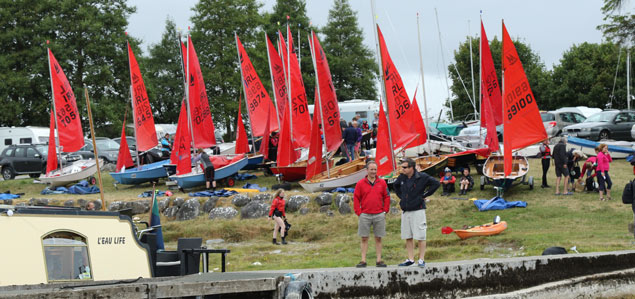 18 Mirrors competed at Double Ree Photo: Simon McIlwaine
18 Mirrors competed at Double Ree Photo: Simon McIlwaine
However, it wasn’t all just Swallows & Amazons! Though the fun factor was high, the racing too was of a high standard and very competitive. Lake sailing for some can be a challenge but often this is perception, though when wind shifts happen, they can do so in style!
"Though the fun factor was high, the racing too was of a high standard and very competitive"
Race Officer David Dickson provided 4 great races on Saturday made tricky by the light conditions that prevailed with plenty of generous wind shifts. Running the four fleets on the same race area was always going to be adventurous as they were all started from the same line and on same race area but had two separate trapezoid courses with the 29ers & 420’s sailing on a longer course and the Mirrors & Fevas on a slightly shorter course. But Dickson ran the races off efficiently, quickly learning to adapt to ensure minimal crossover of the fleets. By Sunday it was down to a fine art with an additional three races executed in relatively quick succession. Highlight results for all four fleets can be downloaded below.
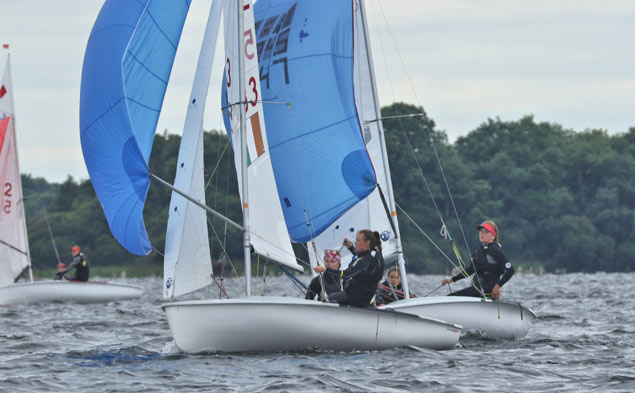 420s racing at Double Ree Photo: Simon McIlwaine
420s racing at Double Ree Photo: Simon McIlwaine
A big thanks to Lough Ree Yacht Club and the many volunteers it took to run such an event, it was clear that the stops were well and truly pulled out both on and off the water. The question now is whether Double Ree should be held every Double year! Have your say in our reader poll below.
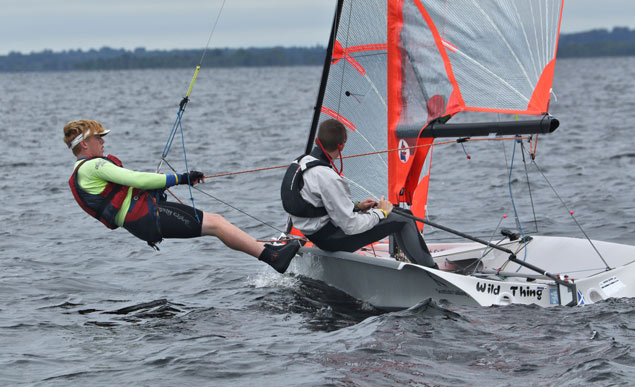 Eight 29ers raced on Lough Ree Photo: Simon McIllwaine
Eight 29ers raced on Lough Ree Photo: Simon McIllwaine
Irish Laser Boy & Girl Set for Youth Sailing Worlds After International Standard Met in Wales
The single–handed winners of the Easter domestic Laser trials held on Dublin Bay as part of the youth pathway championships are set to take their place at the Youth Sailing Worlds in the USA after making the required international standard. The qualifying results were achieved at the UK Laser Association Radial Qualifier at Pwllheli SC in North Wales last weekend.
Royal St. George's Radial Boy Jack Fahy who came from behind on Dublin Bay to win the Easter prize on the final day was seventh overall in his 56-boat fleet in Pwllheli, an opening race win easily putting him inside the top 20% of his fleet, the required international minimum set down by Irish Sailing.
The National Yacht Club Laser Youth Girl Champion Nell Staunton also made the cut for the Youth Worlds in Texas this July.
Results from Pwllheli are here. The results are subject to ratification by the Olympic Sailing Group which is 'expected to happen quickly', according to team manager James O'Callaghan.
The 420 double–handed international event at which Pathway winners Nicola and Fiona Ferguson, also of the National Yacht Club, must make top 20% of the UK fleet has not taken place yet.
Youth Sailors Conquer All on Dublin Bay: Five Sailing Titles in Radial, 420, Topper & Optimist Decided
The answer was written in the weekend's weather forecast: whoever could master the vagaries of Dublin Bay's light winds could count on victory at this year's Irish Sailing Youth National Championships at Dun Laoghaire Harbour.
After three days of racing, only one of the early leaders from Thursday's races in a near gale had held on to their overall lead by Sunday's windless conclusion.
As Afloat.ie reported earlier, 213 competitors from 26 clubs around Ireland competed in a series that, although it had breeze throughout the wind range, will be remembered as a light air test, and a severe one at that, with some serious wind shifts in the tentative south–easterlies.
"the weekend winners also earned a nomination to represent Ireland at this July's World Youth Sailing Championships in the USA, subject to international standards being met"
Five titles were decided with selection for squads and Irish Sailing Academy places also at stake for the under–18 sailors. And, as an added bonus, the weekend winners also earned a nomination to represent Ireland at this July's World Youth Sailing Championships in the USA subject to meeting the required international standards. Winners have the chance to make that top 20% standard required in both Laser and 420 classes, at selected events later this month.
Justin Lucas Wins Optimist Battle of the Bay
Royal Cork and Tralee Bay Optimist sailor Justin Lucas led his 78–boat fleet from start to finish. Although his lead was narrowed overnight by national champion Rian Geraghty-McDonnell of the National Yacht Club, Lucas proved a true champion again this year by finishing race ten of the series this afternoon with another win, his fourth of the weekend.
 Optimist winner Justin Lucas of RCYC & TBSC scored 1, 1, 1, (19), 2, (14), 9, 5, 12, and 1 in the ten race series to win by a point Photo: Afloat.ie
Optimist winner Justin Lucas of RCYC & TBSC scored 1, 1, 1, (19), 2, (14), 9, 5, 12, and 1 in the ten race series to win by a point Photo: Afloat.ie
Lucas defeated Johnny Flynn from Howth Yacht Club by a single point. Lucas was one of three Royal Cork Yacht Club competitors in the top six and the club had largest representation at the event.
Emily Riordan of the Royal St. George Yacht Club placed 12th in the Optimist class and was top girl overall, three places ahead of Tralee Bay Sailing Club’s Eimer McMorrow-Moriarty.
Jack Fahy on Top in Laser Radial
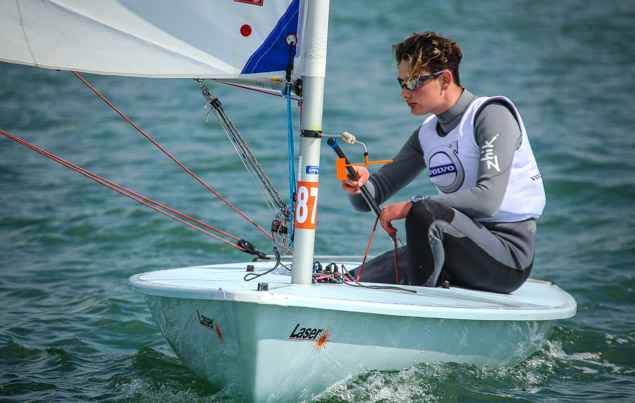 Jack Fahy Laser Radial winner from the RSGYC, RCYC and LDYC scored 3, 10, 2, 5, 4, 1.0 (11.0) to win by two points. Photo: Afloat.ie
Jack Fahy Laser Radial winner from the RSGYC, RCYC and LDYC scored 3, 10, 2, 5, 4, 1.0 (11.0) to win by two points. Photo: Afloat.ie
The Laser Radial class had incredibly close racing and any one of four or five top sailors could have won overall in the final two nail biting races. In the end, after some clever sailing, Jack Fahy emerged on top after a fourth place and a win swept him into the overall lead by two points. Royal St. George Yacht Club club–mate Tom Higgins took second while series leader Jamie McMahon of Howth Yacht Club, who had lead the competition since winning both of Thursday’s races, finished third overall, three points behind Fahy.
Top Radial girl, in seventh place, was Nell Staunton of the National Yacht Club.
National's Ferguson Sisters Win 420 Title
 420 winners Nicola and Fiona Ferguson of the National Yacht Club counted (3.0), 3.0, 1.0,1.0, 3.0, 1.0, 2.0 and 3.0 to win by three points Photo: Afloat.ie
420 winners Nicola and Fiona Ferguson of the National Yacht Club counted (3.0), 3.0, 1.0,1.0, 3.0, 1.0, 2.0 and 3.0 to win by three points Photo: Afloat.ie
In the 16-strong International 420 class, girl crews ruled the podium in a close contest that saw hard–working sisters Nicola Ferguson and Fiona Ferguson of the National Yacht Club count all races in the top three to win overall by three points ahead of early leaders Gemma McDowell and Emma Gallagher of Malahide Yacht Club in second and Grace O'Beirne with Kathy Kelly of the Royal St George Yacht Club in third.
Strong Performance by Royal Cork
In a strong showing for Cork Harbour, Royal Cork Yacht Club can make a claim to have won three of the five titles even though, admittedly, some winners are sailing under the burgees of several clubs. For example, Radial winner Jack Fahy entered under three clubs: Royal St George Yacht Club, Royal Cork Yacht Club and Lough Derg Yacht Club. Likewise Justin Lucas hails from Royal Cork and Tralee.
The Irish Sailing event was co-hosted by Dun Laoghaire neighbours National YC and Royal St. George YC.
 Toppers sailed six races across three days. Photo: Afloat.ie
Toppers sailed six races across three days. Photo: Afloat.ie
Topper Titles Goes to Kohl and Jones
Three classes started racing on Saturday and completed a six-race series that saw Atlee Kohl of the Royal Cork Yacht Club win the Laser 4.7 class while club-mate David Jones took the Topper 5.3 fleet. Blessington Sailing Club’s Christian Houlihan won the Topper 4.2 class.
Overall results are here
Link to all Afloat.ie's Youth Sailing Nationals coverage here
Final Races to Decide Youth Sailing Titles on Dublin Bay
After a fickle day three of the Volvo Youth National Sailing Championships, dinghy class leaders clung to the top of their respective scoresheets but only just.
Organisers were also breathing a sigh of relief after completing the minimum race requirements for the championships in three classes as tricky light southerly winds and fog on Dublin Bay threatened the 2018 schedule.
Following Thursday's heavy air start then Friday’s cancellation of racing due to near gale force winds, the third day offered completely different challenges.
Against the odds, race officials did well to complete a number of races on three separate Bay courses.
Although the race management teams planned an early start to the day, early morning fog was slow to clear but left a moderate breeze in its place. This gave way to near calm conditions by lunchtime followed by a return of sea fog with competitor boats gathered close to their committee boats before racing resumed in the mid-afternoon.
Three more classes joined the championships today in what turned out to be a six-hour day afloat, bringing the turnout to 196 boats and 213 competitors.
The Irish Sailing event is being co-hosted by the National YC and Royal St. George YC.
 Optimist dinghies line up for a start that is then postponed
Optimist dinghies line up for a start that is then postponed
In the Optimist trials event, Justin Lucas of the Royal Cork Yacht Club saw his lead pared back a little by national champion Rian Geraghty-McDonnell of the National Yacht Club in second place but still has a comfortable seven-point lead.
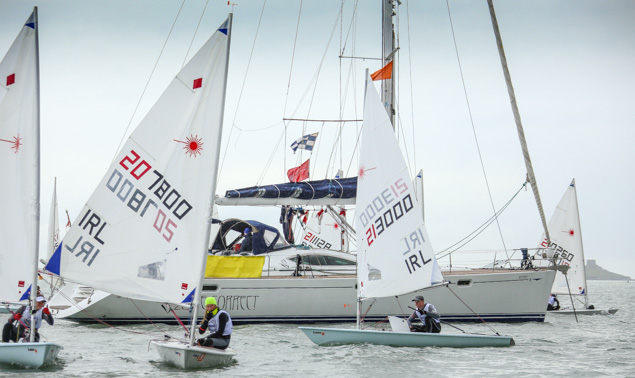 Overall leader Jamie McMahon (213000) among a fleet of 34 Laser Radials waiting for racing to resume at the Committee Boat in Scotsman's Bay
Overall leader Jamie McMahon (213000) among a fleet of 34 Laser Radials waiting for racing to resume at the Committee Boat in Scotsman's Bay
After two straight wins on Thursday in the Laser Radial class, Howth Yacht Club’s Jamie McMahon also retains the overall lead of his class but with unrelenting pressure from Peter Fagan of the Royal St. George Yacht Club just two points behind.
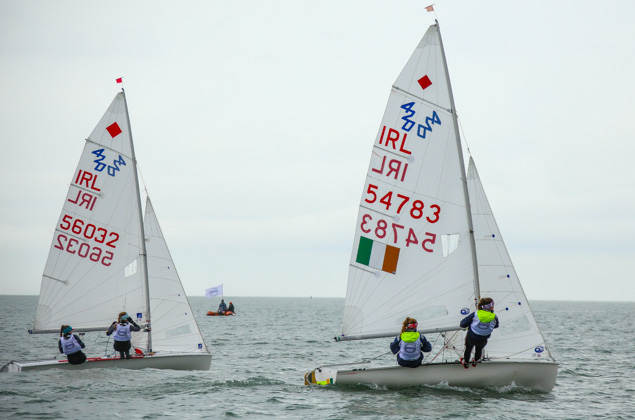 Overall 420 leaders Nicola Ferguson and Fiona Ferguson (56032) of the National Yacht Club neck and neck with fourth overall Grace O'Beirne and Kathy Kelly of the Royal St George Yacht Club in the beat to the finish of race five Photo: Afloat.ie
Overall 420 leaders Nicola Ferguson and Fiona Ferguson (56032) of the National Yacht Club neck and neck with fourth overall Grace O'Beirne and Kathy Kelly of the Royal St George Yacht Club in the beat to the finish of race five Photo: Afloat.ie
Nicola Ferguson and Fiona Ferguson of the National Yacht Club and Gemma McDowell with Emma Gallagher of Malahide Yacht Club are on the same eight points of the 420 class proving their abilities across the wind range over the two days.
Meanwhile, of the three classes that joined the event today, Alana Coakley of the Royal St George Yacht Club leads the Laser 4.7 fleet, David Jones of the Royal Cork Yacht Club leads the Topper 5.3 class while Christian Houlihan of Blessington Sailing Club leads the Topper 4.2 class.
Sunday’s final day is scheduled to again have an early start with Warning Signals on all courses planned for 1000 hrs and up to four races – weather permitting.

See overall results here
Despite the Weather, Irish Youth Pathway Nationals Brings Fresh Perspective on Junior Sailing & Dun Laoghaire Harbour
With 190 sailors from 25 clubs nationwide, the first ever Northern Ireland–hosted Youth Pathway Nationals 2017 at Ballyholme last year had a debut which was little short of sensational. The momentum has been maintained into 2018 for a real talent-spotting championship, and this weekend we’re in the midst of a participation of 213 young sailors in 197 boats, and they represent 28 clubs which vie with each other to provide the best possible infrastructure, training and logistical support for their very active junior sections. W M Nixon reflects on the many implications of both the event and this year’s venue, together with the volunteers who make it possible.
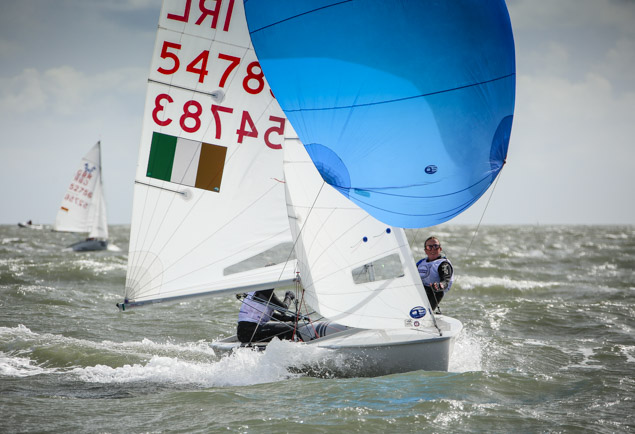 Dublin Bay as it can be – Gemma McDowell and Emma Gallagher of Malahide revelling in the first day’s sunshine racing with their top-placed 420. Photo: Afloat.ie/David O'Brien
Dublin Bay as it can be – Gemma McDowell and Emma Gallagher of Malahide revelling in the first day’s sunshine racing with their top-placed 420. Photo: Afloat.ie/David O'Brien
They’d a beautifully sunlit early morning start on Thursday in Dublin Bay, with a rising south to southeast breeze as the first races started at noon. But by 2pm the forecast greyness was beginning to spread up over the sky from the south, and soon the sunshine was only a memory. A vivid one nevertheless, but only the Optimists, 420s and Laser Radials on the complete four day programme benefitted from this brief yet very welcome respite from the longest winter in living memory.
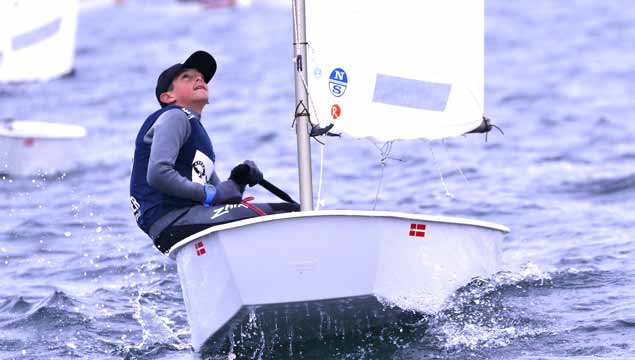 The Champion from Clon…..Justin Lucas of Clonakilty, Tralee Bay SC & Royal Cork, is ahead in the Optimist fleet
The Champion from Clon…..Justin Lucas of Clonakilty, Tralee Bay SC & Royal Cork, is ahead in the Optimist fleet
They made the best of it, with 14-year-old Justin Lucas of Tralee Bay and Royal Cork (the word is he lives in Clonakilty) continuing his stellar progress as the pace-setter of the 70-strong Optimist class, with three wins in three races. But the two hosting clubs were in there battling away, with Moss Simington (RStGYC) finishing the day second overall on an 8, 2 and 14, while the National YC’s Rian Geraghty-McDonnell and Nathan van Steenberge were third and fourth on 7,5,2 and 10,9,5 respectively.
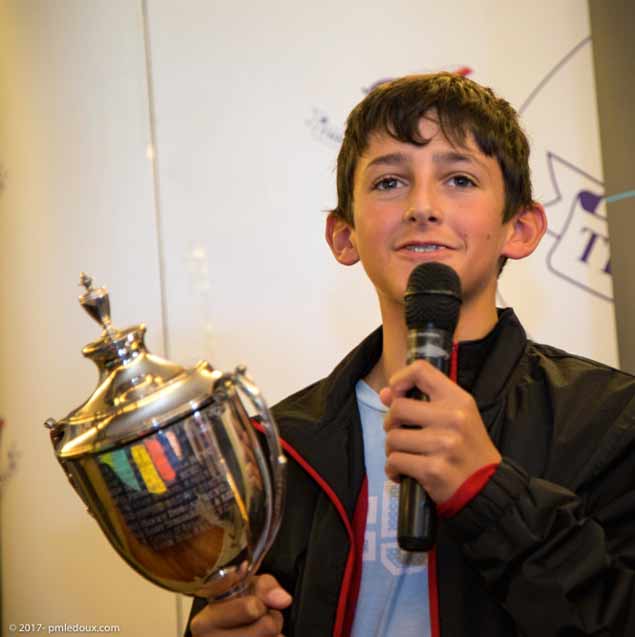 Winning speech – Justin Lucas is already well accustomed to taking big prizes, and he can handle success with grace and style
Winning speech – Justin Lucas is already well accustomed to taking big prizes, and he can handle success with grace and style
The Laser Radials and 420s got in two races, and in a repeat of last year in the Lasers, it was a McMahon of Howth out in front. But in 2018 it is Ewan McMahon’s younger brother Jamie who is doing the business on behalf of one of Ireland’s “sailingest” families - sister Eve is a star as well. On Thursday, Jamie logged two wins while Peter Fagan had two seconds and Hugo Kennedy took a 4th and third.
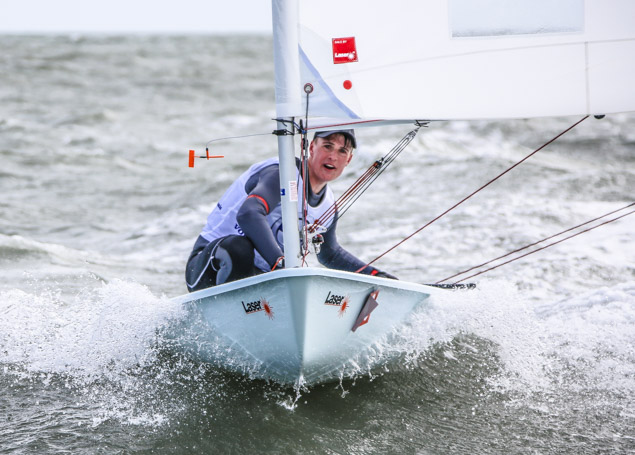 Jamie McMahon. The McMahons of Howth are like the No 33 bus – if you missed one winning a race, then another one will be along soon. Last year, Ewan McMahon dominated the Laser Radials in the Youth Pathway Championship. This year, it’s his brother Jamie. Photo: Afloat.ie
Jamie McMahon. The McMahons of Howth are like the No 33 bus – if you missed one winning a race, then another one will be along soon. Last year, Ewan McMahon dominated the Laser Radials in the Youth Pathway Championship. This year, it’s his brother Jamie. Photo: Afloat.ie
The 420s were looking good initially for 2017 Irish Junior Champion Micheal O’Suillebhain of Cork – with regular crewmate Michael Carroll, he won the first race. But a capsize in the second race had him out of it altogether, and Gemma McDowell and Emma Gallagher of Malahide quickly stepped into the breach - they’d been second the first time out, they now confirmed the overall lead by winning, with Morgan Lyttle and Patrick Whyte second overall on 4,2 and Nicola & Fiona Ferguson third with two thirds.
 Final preparations for a good day afloat – Emma Gallagher and Gemma McDowell with their 420. Photo: Irish Sailing/Facebook
Final preparations for a good day afloat – Emma Gallagher and Gemma McDowell with their 420. Photo: Irish Sailing/Facebook
 The triumphant return – Gemma McDowell on helm and Emma Gallagher on trapeze blasting back into Dun Laoghaire Harbour after winning the first day
The triumphant return – Gemma McDowell on helm and Emma Gallagher on trapeze blasting back into Dun Laoghaire Harbour after winning the first day
When the class numbers went up to five yesterday with the Toppers and Laser 4.7s due to start their three day programme, it was back to the “new normal” on the weather front, and the start of racing was postponed to 2.00pm which then became total cancellation. There’d been a foul night of wind and rain which made you wonder if the ISPCC might come sniffing around the place, for there’s many a neighbourhood and a society where they’d think that sending kids out in little boats in weather like that is a deliberately calculated form of cruelty.
But having been an Oppie dad back in the day (it was so long ago that everyone called them Oppies at the time - the contemporary PC version “Opty” still doesn’t trip off the tongue), I never ceased to be amazed by the kids’ determination to get in some racing no matter what the weather. As to their notions of the voyaging an Optimist might be capable of during lay days, that didn’t bear thinking about – they’d put food for a day on board, and were prepared to sail for the horizon if they could get away with it.
This particular Oppie dadship ended in an interesting way, when my sole duty was to deliver the youngest son to an Optimist event, and then bring him back when it was over. None of this hands-on Oppie parenting stuff in our family – it was indicated that I was to make myself scarce between start and finish. When you’re a flustered haulier like that, at the close of the event you just link up with the junior skipper, hitch up with the boat trailer, and head for home. Thus it was some time before I noticed that as often as not, I was bringing back a different boat. Our little baby boy had become a successful Oppy dealer. And he soon wanted to move onto bigger things, which he has continued to do successfully ever since.
As for not noticing which particular boat I was towing, let it be said that there’s a renowned Dun Laoghaire character who was road-trailing a Dragon home from a major event in Brittany, and he was many kilometres along the route before he realized he’d got the wrong boat. But that’s by the way. My own limited Oppy dad experience is only to show that these kids are tough and extremely competitive, and we should save at least as much sympathy for the huge numbers of weather-battered volunteers who are beavering away through the four day programme to keep this complex regatta moving towards the target, which at the very least is to get a valid result.
 Con Murphy is the total sailor – longtime Round Ireland Record holder, and Race Officer par excellence. Here he is on the right with Irish Sailing's Ross Killian (centre) and Pat Donnelly addressing participants at the National Yacht Club on Friday
Con Murphy is the total sailor – longtime Round Ireland Record holder, and Race Officer par excellence. Here he is on the right with Irish Sailing's Ross Killian (centre) and Pat Donnelly addressing participants at the National Yacht Club on Friday
On the three course areas as shown on our leader photo, former NYC Commodore and longtime Round Ireland Record holder Con Murphy (he set the record in 1993) is in charge of the big girls and boys’ racing with the 420s and Laser Radials, and he’s aboard Johnny McClean-Roberts’ cruiser in the more exposed area northeast of the harbour. He’s well-placed in terms of committee boat comfort, as Johnny’s vessel is the well-appointed Jeanneau 54 DS Quite Correct, which some years ago carried out the textbook rescue in the Irish Sea of the crew of a sinking boat whose spade rudder had torn adrift leaving a large hole in its place, resulting an award-winning exercise by Quite Correct, master-minded by Johnny’s longterm shipmate Brian Mathews.
Eddie Totterdell of the National YC is on one of the Dublin Bay SC Race Officer catamarans looking after the Toppers and Laser 4.7s to the northwest of the harbour. His continuing services to sailing are the stuff of legend, so it was thought only right and proper that when the draw was taken at the Sailors of the Year Awards ceremony in the RDS in February, the winner of the prize for two VIP places at the finish of the Volvo Ocean Race at The Hague in June should go to Eddy Totterdell – no better man.
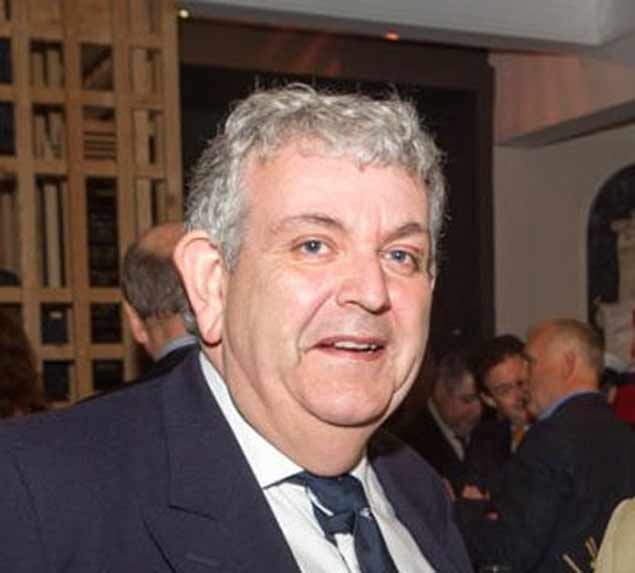 Another of Irish sailing’s great volunteers, Eddie Totterdell is the very popular winner of the VIP ticket to the finish of the Volvo Ocean Race in June
Another of Irish sailing’s great volunteers, Eddie Totterdell is the very popular winner of the VIP ticket to the finish of the Volvo Ocean Race in June
It’s interesting to note that a recent news item on the Topper Class here on Afloat.ie featured a request that anyone interested in joining the Irish Topper Class Committee should please get in touch pronto, for although the Toppers fit a definite niche in the market very precisely, that niche is for only a very few years. Then the young skippers and their committee-serving parents move on to bigger boats, so keeping the committee up to strength is a recurring problem.
It’s not one which seems likely with the Optimists, which are racing to the west of the harbour. They’re far and away the largest class numerically with something like 70 boats already racing, and maybe eighty in all if conditions start to suit the newer youngest sailors.
The Race Officer in their relatively sheltered area is Lough Derg Yacht Club Commodore John Leech, best-known in sailing as a stalwart of the Shannon One Design class, and a member of one of the leading sailing families along the rivers and lakes.
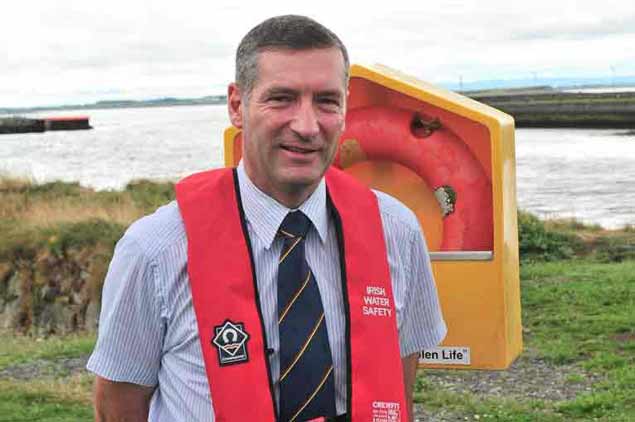 Lough Derg YC Commodore John Leech, who is Chief Executive of Irish Water Safety, is another volunteer giving sterling service as a Race Officer for the Youth PathwayNationals.
Lough Derg YC Commodore John Leech, who is Chief Executive of Irish Water Safety, is another volunteer giving sterling service as a Race Officer for the Youth PathwayNationals.
His brother Garrett recently became Commodore of Lough Ree Yacht Club, which must lead to a certain level of sibling rivalry, for although Lough Derg YC dates back to 1835, Lough Ree has its roots in 1770, which makes it the second-oldest club in Ireland, bested only by the Royal Cork YC itself.
This all means that 2020 is going to be quite a year for club anniversaries, and there are already three clubs on the podium – the National YC is going to be in the Bronze Medal position at 150 years old, Lough Ree is firmly in Silver at 250 years, and Royal Cork is undoubtedly Gold Medallist at 300 years old.
Discussions of such matters will have helped to pass the time as they waited for conditions to abate to allow racing to resume. Another surefire topic is the future direction of Dun Laoghaire Harbour, a matter exacerbated by the damage sustained in the recent storms. How will such repairs be paid for in the long run? Should it be seen as much as a National Heritage site as much as a harbour?
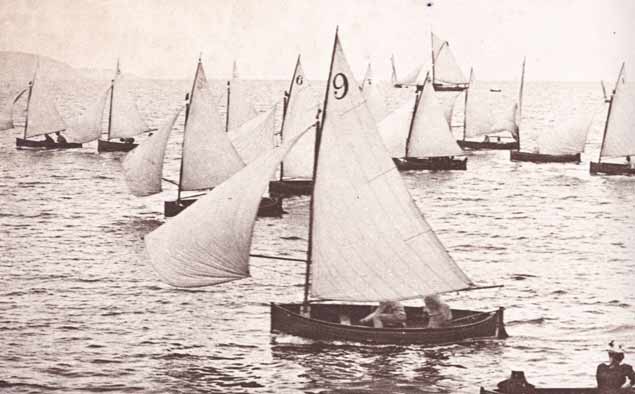 Dun Laoghaire Harbour’s exceptional role as a National Heritage site is emphasized by considering how this photo of the original 1887 Water Wags taken from the end of the East Pier in the 1890s….Photo courtesy Water Wag Class
Dun Laoghaire Harbour’s exceptional role as a National Heritage site is emphasized by considering how this photo of the original 1887 Water Wags taken from the end of the East Pier in the 1890s….Photo courtesy Water Wag Class
 …….is complemented by this contemporary photo of their successors which were introduced in 1900, as seen from seaward in the same location
…….is complemented by this contemporary photo of their successors which were introduced in 1900, as seen from seaward in the same location
Well, as one of the points made in all the debates about the Old Granite Pond is that for all its artificial origins, there’s something about Dun Laoghaire Harbour which makes it seem like a natural feature of Dublin Bay, why not treat it as just that, and look on repairs as being the treatment of coastal erosion, rather than ordinary harbour maintenance matters?
Meanwhile, the wayward low pressure area which was causing all the trouble was tracking just a little too slowly up the west coast to save yesterday’s hoped-for afternoon races. In such a situation, the prompt decision to call off any prospect of further racing before today (Saturday) was much the best option.
We go into the weekend with two days left of the programme knowing that the Optimists need only one more race to have a championship result, while the Laser Radials and the 420s need two further race results, but the Toppers and the Laser 4.7s will need three. However, with the racing scheduled to start at 10.30am, it should be well manageable. But for now, the young sailing people of Ireland are surely learning even more about the weird weather we have to live with, because as the localised high pressure area forecast for today materialises, we’ll be looking at a Dublin Bay transformed.
Youth Sailing Nationals Day Two 'Postponed' as Winds Forecast To Reach 40mph. UPDATED
Racing in day two of Irish Sailing's Volvo Youth National Championships at Dun Laoghaire has been postponed. The next update will be made at 2pm, according to Race Officer Con Murphy at the National Yacht Club.
UPDATE at 2pm: Racing abandoned for the day. First gun tomorrow at 10.30am.
Weather forecasts indicate strong southerly winds gusting to 40 mph on the three Dublin Bay race areas this afternoon.
Currently, there is low visibility on the Bay, winds are from the South East and gusting to 39 knots, according to the Dublin Bay weather buoy.
Water Temp:6.5 °C, Avg Wind:27kts, Gust:39kts, Wave Height:1.7m, Wave Period:4s, Gust Dir:133 °(SE) at 06/04/2018 12:11:00
— Dublin Bay Buoy (@DublinBayBuoy) April 6, 2018
200 sailors are contesting the dinghy championships that is hosted by the Royal St. George Yacht Club and National Yacht Clubs in Laser Radial, 420, Topper and Optimist classes.
Three races are scheduled for all five classes today. Racing continues until Sunday.



























